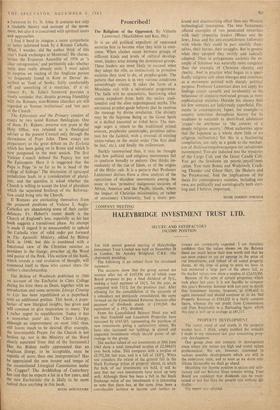Proscribed!
The Religions of the Oppressed. By Vittorio Lanternari. (MacGibbon and Kee, 50s.) IT is an old political expedient of oppressed societies first to become what they wish to over- come. When clashes occur between groups of different kinds and levels of cultural develop- ment, leaders arise among the dominated groups. These leaders are most likely to succeed when they adopt the role, as instinctively in primitive societies they tend to do, of prophet-guide. The pattern that ensues is in very various conditions astonishingly similar. It takes the form of a Messianic cult with a salvationist programme. The faith will be syncretistic, borrowing what seems expedient from both the native tradi- tionalist and the alien superimposed myths. The entranced prophet-guide believes that he receives the message by divine revelation. The divinity may be the Supreme Being or the Great Spirit or a deified ancestral or tribal hero. The mes- sage urges a return to the traditional, primal sources, prophesies catastrophe, promises salva- tion for the faithful, with a reversal of existing status-values in the social order (`the first shall be last,' etc.), and finally the millennium.
Starkly summarised thus, it may be thought that few political and religious movements fail to conform broadly to pattern. One thinks im- mediately of the rise of Islam, or of the origins of the Hitler cult. It is a pattern that Professor Lanternari derives from a close analysis of 'the operations of dissident movements among the more or less `primitive' indigenous societies of Africa, America and the Pacific islands, where the impact of Christian missionaries, or rather of missionary Christianity, had a more pro- found and disconcerting effect than any Western technological innovation. The two Testaments offered examples of two persecuted minorities with their respective leaders (Moses and the Jews, Jesus and his anti-establishment followers) with whom they could in part identify them- selves, their heroes, their struggles. But in general what they adopted they swiftly and radically adapted. Thus in polygamous societies the ex- ample of Solomon was naturally more congenial than the example of Christian chastity and charity. And in practice what began as a speci- fically religious cult often emerges and continues as a movement pointed with sharply political purpose. Professor Lanternari does not apply his findings except casually and incidentally to the behaviour of similarly-motivated groups in more sophisticated societies. Outside his chosen field his few ventures are ludicrously superficial. Fer- ments in contemporary Japan, for example—a country notorious throughout history for its readiness to succumb to short-lived adolescent `crazes'—he attributes to `the context of a deeply religious society.' (Most authorities agree that the Japanese as a whole show little or no religious inclination.) Yet this is a fascinating compilation, not only as a guide to the mechan- ism of Heilsivartungsbewegungen (or salvationist movements). You are inducted into the mysteries of the Cargo Cult and the Great Candle Cult. You get the lowdown on peyote/peyotl /mes- caline. You meet Bonzo and Wodziwob, Crash- ing Thunder and Ghost Shirt, the Shakers and the Potawatomi. And the implications of the thesis for contemporary societies, including our own, arc politically and sociologically both start- ling and, I believe, important.
HUGH GORDON PORTEUS






































 Previous page
Previous page